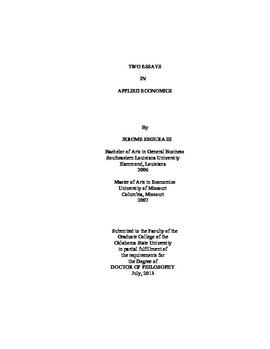| dc.contributor.advisor | Rickman, Dan S. | |
| dc.contributor.author | Segura, Jerome | |
| dc.date.accessioned | 2014-09-24T14:17:06Z | |
| dc.date.available | 2014-09-24T14:17:06Z | |
| dc.date.issued | 2013-07 | |
| dc.identifier.uri | https://hdl.handle.net/11244/11042 | |
| dc.description.abstract | I provide two exercises which attempt to arrive at consistent estimates through the utilization of various instrumental variable (IV) and general method of moments (GMM) estimation approaches. My first study asks: is social network formation pro-cyclical or counter-cyclical? While viewing social network formation as an investment concept at the individual level is well-established, how this mechanism is affected by aggregate fluctuations has not yet been studied. I use the General Social Survey (1972-2010) to empirically test the net effect of aggregate fluctuations on individual-level social network investment. In my estimation, I attempt to address the reflection problem through the application of the Lee (2007) linear-in-means model which is most recently applied in Bramoull? et al. (2009) and Boucher et al. (2012). I also attempt to address possible bias resulting from unobserved heterogeneity. My findings indicate that social network investment is counter-cyclical. I use alternative measures of business cycle fluctuations and ad-hoc reference group formations; the results remain robust to these alternative measures and specifications. My second study asks: what are the growth effects of state and local fiscal policy. In deriving my estimable equation I combine a partial adjustment process with a factor market approach for modeling regional output. I utilize dynamic panel data estimation procedures in an attempt to arrive at a more refined set of estimates for the growth effects associated with state and local fiscal policy. I use annual observations for 48 contiguous U.S. jurisdictions ranging from 1977-2008 to empirically test the net effect of government fiscal policy on the growth rate of gross state product (GSP). To my knowledge, this is the first study which attempts to address the potential endogeneity of state and local fiscal policy. My findings indicate a large degree of heterogeneity between regions in response to effective tax rate hikes by state and local government. Although these results are robust to an alternative sample and following a reduction in the number of instruments, I am unable to verify the robustness of the estimated coefficients after a number of other alternative specifications. I interpret the results as an indication that policymakers should err on the side of caution in extrapolating the results of empirical studies to their own states and time periods. | |
| dc.format | application/pdf | |
| dc.language | en_US | |
| dc.rights | Copyright is held by the author who has granted the Oklahoma State University Library the non-exclusive right to share this material in its institutional repository. Contact Digital Library Services at lib-dls@okstate.edu or 405-744-9161 for the permission policy on the use, reproduction or distribution of this material. | |
| dc.title | Two essays in applied economics | |
| dc.contributor.committeeMember | Munasib, Abdul B. A. | |
| dc.contributor.committeeMember | Maguire, Karen | |
| dc.contributor.committeeMember | Shideler, Dave | |
| osu.filename | Segura_okstate_0664D_12985.pdf | |
| osu.accesstype | Open Access | |
| dc.type.genre | Dissertation | |
| dc.type.material | Text | |
| thesis.degree.discipline | Economics | |
| thesis.degree.grantor | Oklahoma State University | |
